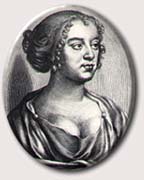 |
 by John Butler  1. Biography
1. BiographyKatherine Philips was born Katherine Fowler on January 1, 1632. Her father was a London merchant and a moderate puritan. She was educated at Mrs. Salmon's School in Hackney (London) where she met Mary Aubrey, the "Rosania" of her poems, and Mary Harvey, later the wife of Sir Edward Dering, who became "Silvander." Katherine's father died in 1639, and her mother remarried in 1646 to a Welsh baronet. Katherine's new stepfather married Katherine to a relative of his, James Philips. When the couple married in 1648, Philips was thirty-eight years older than Katherine, who was sixteen. James Philips was a prominent Parliamentary supporter who signed Charles I's death-warrant in 1649. Katherine seems to have started to write poetry soon after she got married, and she was "discovered" by the poet Henry Vaughan, who praised the work of "The Matchless Orinda" in his Olor Iscanus. Vaughan subsequently published a memorial poem Katharine had written for the poet and playwright William Cartwright (1611-1643). It was at this time that she began to use "Orinda" as a pen-name, and wrote poetry principally of a personal nature to Mary Aubrey, her "Rosania". After Mary's marriage Katharine's chief poetic "correspondent" became Anne Owen, or "Lucasia." During the Civil War Katherine harboured royalist sympathies in spite of her puritan upbringing and marriage; she duly celebrated the Restoration in 1660, but could not avoid being caught up in her husband's problems. As a regicide, James Philips was lucky to avoid prosecution, but he lost his position as an MP, and most of the land he had acquired as a gift from Lord Protector Oliver Cromwell was reposessed by the Crown. In the end, however, Katherine was lucky; her husband's reputation was saved by Sir Charles Cotterell, Charles II's Master of Ceremonies. Cotterell was interested in the hand of Katherine's friend Anne Owen, and because of the help given to him by the Philipses, Cotterell interceded for James Philips. In the end, Anne did not marry Cotterell, but Katherine and Cotterell remained friends, and it was he who prepared her poems for publication after her premature death from smallpox in 1664, just after she had returned to England from a visit to Anne in Ireland. In her lifetime Philips saw only two of her books in print. The first was a translation of Corneille's play La mort de Pompee, which her fellow-dramatist the Earl of Orrery had staged in Dublin, and which was printed shortly afterwards (1663). The second, unauthorized, book was Poems by the Incomparable Mrs. K.P. (1664), which was withdrawn a few days after publication because Katherine objected on the grounds that the text was inadequately printed. Cotterell's "authorized" edition of the Poems appeared in 1667, with further editions in 1669, 1678, and 1710--a considerable achievment for a dead female poet. Her letters to "Poliarchus" (Cotterell) were published in 1705. 2. Reputation and Criticism In her own time, Katherine Philips was seen as a respectable antidote to the notorious Aphra Behn, who was considered by many amongst the great and good as immoral and coarse. Certainly Orinda's poetry is refined, and for that reason she became the best-known female poet of her generation, winning praise from Dryden and others. Modern feminist critics have extolled Orinda because of her praise of female Platonic friendship and the interest aroused in scholars by female coteries in the seventeenth century, although some denigrate her because she did not encourage her relationships to go beyond the intellectual level. Her translation of Corneille is accurate and well-conceived. Her poetry is elegant, but much of it is also rather vapid; it is written simply and straightforwardly, and it sometimes exhibits fairly strong feelings, but there is never much beyond the conventional. Orinda was a "safe" female poet for women to read and men to praise. She certainly took her intellectual friendships seriously, but as Greer has remarked in Kissing the Rod, "the flame is always pure, the relationship strictly Platonic, a meeting of souls, never the flesh" (190). 3. Philips in Print A good selection of her poetry may be found in Germaine Greer's excellent anthology Kissing the Rod: An Anthology of Seventeenth Century Women's Verse (London: Virago, 1988). Alastair Fowler prints eight poems in his New Oxford Book of Seventeenth Century Verse (1991). Her Poems (1667) form Volume 462 of Scholars' Facsimiles and Reprints. Also, see Thomas, Patrick [Ed]. Collected Works. Volume I: Poetry. Stump Cross, 1990. There are two biographies / studies: Philip Souers. Matchless Orinda. Johnson Reprints, 1969. Patrick Thomas. Katherine Philips. University of Wales Press, 1988. Article Citation: Butler, John. "The Life of Katherine Philips." Luminarium. 15 Apr 2003. [Date you accessed the article]. <http://www.luminarium.org/sevenlit/philips/> Katherine Philips | Works | Links | Essays | Books | 17th Century English Literature
Biography ©2003-2007 John Butler. All rights reserved. Published by Luminarium through express written permission. Site copyright ©1996-2007 Anniina Jokinen. All Rights Reserved. Created by Anniina Jokinen on April 15, 2003. Last updated January 24, 2007. Background ©2003-2007 Anniina Jokinen. All Rights Reserved.
|  |
